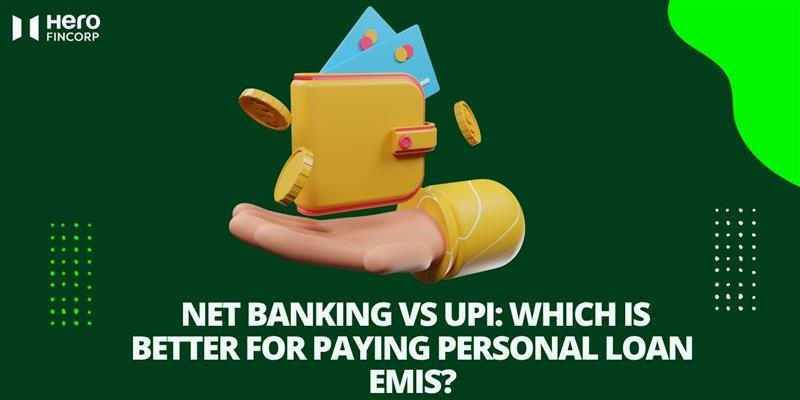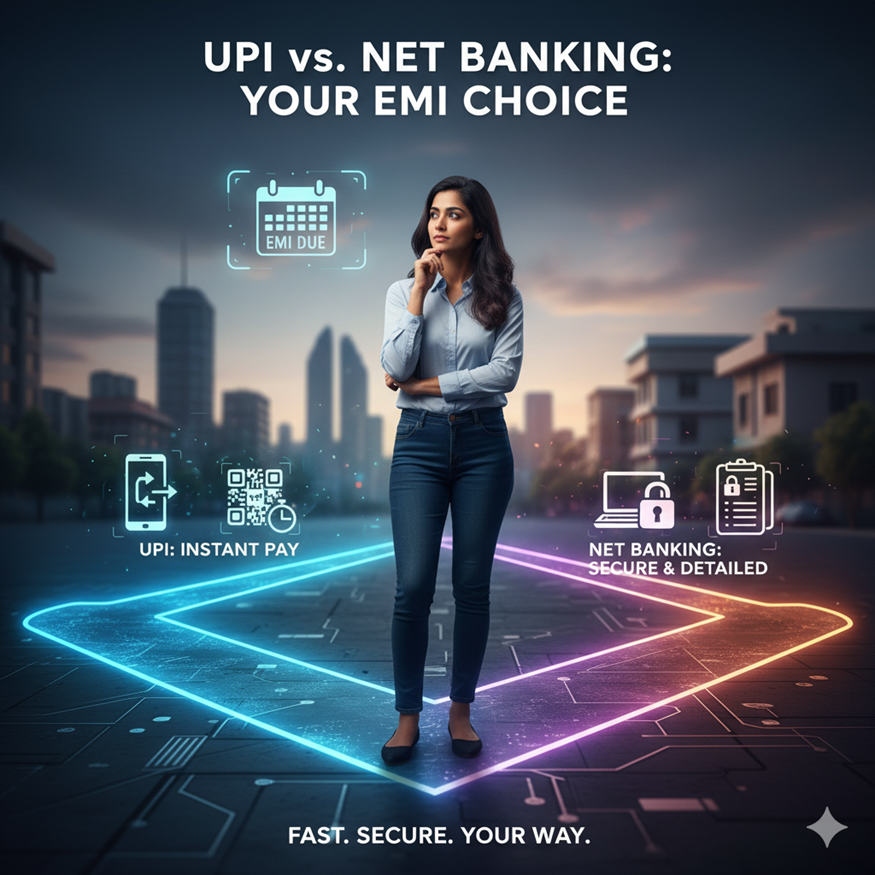Net Banking vs UPI: Which is Better for Paying Personal Loan EMIs?


The past decade has witnessed India's digital payment system completely change the way we manage money. From sending rent to EMIs, all of it is just a tap away. Among them, Net Banking and UPI are the top priority options for Indians.
Although both options offer convenient, cashless transactions, they function in significantly different manners. It is a question of whether you would prefer instant speed (UPI) or absolute control and larger limits (Net Banking) while going for EMI repayment.
So, let's see for repayment of your personal loan EMI, which one is more effective: UPI or Net Banking? We have simplified UPI vs Net Banking for you so that you can make a well-informed decision.
The past decade has witnessed India's digital payment system completely change the way we manage money. From sending rent to EMIs, all of it is just a tap away. Among them, Net Banking and UPI are the top priority options for Indians.
Although both options offer convenient, cashless transactions, they function in significantly different manners. It is a question of whether you would prefer instant speed (UPI) or absolute control and larger limits (Net Banking) while going for EMI repayment.
So, let's see for repayment of your personal loan EMI, which one is more effective: UPI or Net Banking? We have simplified UPI vs Net Banking for you so that you can make a well-informed decision.
What is Net Banking?
Net Banking, or Internet Banking, is a facility provided by banks where you can operate your accounts without having to go to a branch. Through your bank's website or mobile app, you can transfer money, make bill payments, open fixed deposits, apply for a loan, or even view EMI schedules.
It's based on a robust infrastructure, with login credentials (User ID and Password) and multi-stage authentication such as OTPs or secure tokens for each transaction. That makes it perfect for large or scheduled payments such as EMIs, where security is more critical than speed.
Here are some reasons to opt for Net Banking -
● Higher Payment Limits - Ideal for bigger EMI values
● Scheduled Payments - Create auto-debits so you never miss a payment date
● Comprehensive Overview - All account and loan information is available under one window
● Security Confidence - Known login processes with strong layers of authentication
● Integrated Services - Handle FDs, loan statements, and transfers as a single package
What is UPI?
Developed by the National Payments Corporation of India (NPCI), Unified Payments Interface (UPI) is a real-time digital payment system. It connects multiple bank accounts into one mobile app, making instant fund transfers possible anytime, anywhere. The best part? It even works on Sundays and bank holidays.
But UPI doesn't use account numbers or IFSC codes. A Virtual Payment Address (VPA) is all you need to send or receive money. It takes place in mere seconds, and you receive instant confirmation, making it perfect for time-critical payments such as personal loan EMIs.
Here’s why many borrowers prefer UPI -
● Instant Payments - Transactions go through in seconds, even on weekends or public holidays
● Simplicity - No lengthy forms or net banking credentials. You need just a UPI pin, and you are good to go
● Transparency - Real-time notifications confirm payment success immediately
● Accessibility - Works on all smartphones and supports multiple bank accounts
Net Banking vs UPI: Head-to-Head Comparison
To understand whether you should choose UPI and Net Banking for your EMI payments, let’s take an example.
Arjun is a tech-savvy marketing executive who likes simplicity and manages all his finances on his phone. His mother, Meera, on the other hand, is a traditional banker and prefers her desktop for managing all her financial activities.
Since Arjun prefers speed and convenience, UPI is the best option for him. His phone is practically his wallet, and it has all the things he needs. When it is time to pay his personal loan EMI, he can open the UPI app, enter his PIN, and make the payment. For him, UPI’s mobile-first approach and instant confirmations make life easier, especially when he’s travelling or juggling multiple payments.
Meera values structure and visibility. When paying her EMI, she likes to check the amount to be paid, her account details, and other financial information that helps her stay at peace.
She logs into her bank’s net banking portal every month, reviews her account, and schedules her EMI through NEFT. It takes a few minutes, sometimes an OTP or two, but she prefers that sense of control and the detailed records that come with it. Net banking, for her, isn’t just about paying bills; it’s about managing her entire financial landscape from one secure dashboard.
Let's now breakdown UPI vs Net Banking side-by-side to help you pick the best repayment method.
Parameters | Net Banking | UPI |
Login Speed | Slower. Requires secure login via bank portal or app using ID, password, and OTP. | Quick mobile access with UPI PIN. No passwords or login needed. |
Transaction Speed | A few minutes (depends on NEFT/RTGS) | Instant, 24×7 |
Transaction Limit | Higher (up to ₹10 lakh or more) | ₹1 lakh per transaction (varies by app/bank) |
Security | Strong multi-layer authentication | PIN-based with device verification |
Convenience | Best for planned or high-value transfers | Ideal for quick, small, or recurring payments |
Fees | Usually free for online transfers | Free or negligible |
Accessibility | Works via desktop or mobile app | Mobile-first; accessible anywhere |
Payment History | Detailed statements and transaction logs | Basic payment history available |
Payment Confirmation | SMS and email receipts ensure traceability. | Instant in-app confirmation post-payment. |
Ideal Use Case | Loan EMIs, large bills, investments | Small EMIs, everyday expenses, instant transfers |
The verdict - UPI wins on speed and ease, while Net Banking leads on control and higher transaction capability. The best option for your needs depends on how you prefer to manage your finances.
Security Comparison: Is Net Banking or UPI Safer?
Now the moot question, which option is safest?
Both Net Banking and UPI are governed by stringent RBI guidelines and use strong protocols, making them fundamentally secure. But the difference lies in the authentication layers.
● UPI Security - Primarily relies on your UPI PIN for transaction authentication and mobile device binding. The VPA ensures your sensitive bank details are never shared with the recipient. Fraud typically occurs due to users sharing their PIN or authorising collect requests unknowingly.
● Net Banking Security - Employs multi-factor authentication, usually a password for login and an OTP for transaction verification. This multiple-layer structure makes unauthorised access more difficult but also makes the process slower.
So while both options are safe, the difference lies in user behaviour and using it responsibly.
Tips for Safe Transactions
● Never Share PINs/OTPs - Neither your bank nor any app will ever ask for your UPI PIN or Net Banking OTP.
● Use Secure Networks - Avoid making financial transactions on public Wi-Fi.
● Verify UPI Requests - Always verify the identity before authorising a 'Collect Request' on UPI, as scammers use this to trick users into sending money.
Step-by-Step Guide: How to Pay Personal Loan EMIs via UPI and Net Banking
Whether you use UPI or Net Banking, both methods make your repayment experience seamless. Let's find out how to pay your EMIs using both methods.
How to Pay via UPI
Step 1 - Open your UPI app (e.g., Google Pay or PhonePe).
Step 2 - Choose “Loan EMI Payment” or scan the QR code of the lender.
Step 3 - Enter your loan account number or UPI ID.
Step 4 - Confirm the EMI amount and authorise payment using your UPI PIN.
Step 5 - Receive instant confirmation of the UPI transaction.
How to Pay via Net Banking
Step 1 - Log in to your bank’s official Net Banking portal.
Step 2 - Select the ‘Bill Pay’ or ‘Loan Payment’ option.
Step 3 - Enter your loan account details.
Step 4 - Verify EMI amount and authorise using OTP.
Step 5 - Save the payment receipt or confirmation page.
Making the Right Choice for Your EMI Payments
Both UPI and Net Banking have revolutionised the way India pays. But considering the pros and cons of both, there is no winner here. It depends on what suits your routine and comfort zone.
When it comes to paying your EMIs, what truly matters is not the payment method you use, but the consistency. Missing a single EMI can dent your credit score or invite severe penalties. That’s why Hero FinCorp makes repayment simple, secure, and flexible, whether you prefer UPI, Net Banking, or auto-debit.
Make the smart choice that fits your life and secure your financial peace of mind. Apply for a personal loan with Hero Fincorp in minutes and start paying EMIs your way, secure, simple, and hassle-free.
Frequently Asked Questions
1. Are there any charges for paying EMIs through UPI or net banking?
In general, all financial institutions make UPI and Net Banking payments of EMIs free. Nevertheless, it is always advisable to verify the policy of your own lender.
2. What happens if my EMI payment fails via UPI or net banking?
The transaction amount is usually instantly reversed to your account. You must attempt the payment again immediately to avoid penalties. If a reversal is delayed, contact your bank and your lender with the transaction reference ID.
3. Is one method better for large payment amounts?
Net Banking is generally better for large payment amounts (above ₹1 Lakh) as its transfer limits (especially RTGS) are significantly higher and often customised to the user's needs. But, UPI has a standard limit of ₹1 Lakh per transaction.